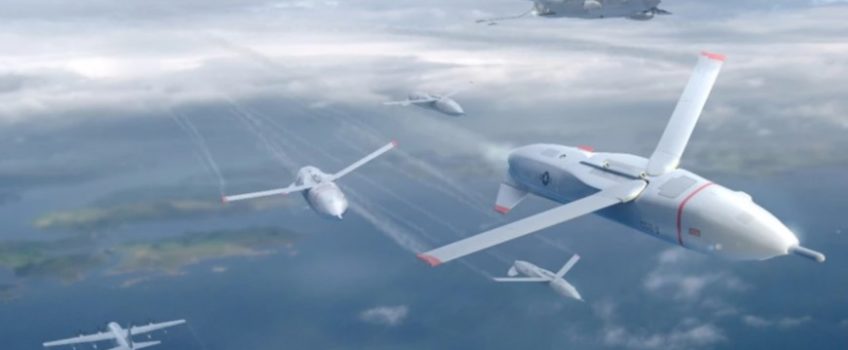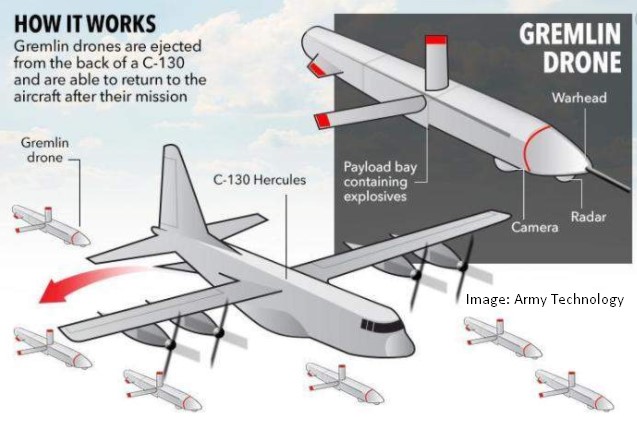
Image Credit: DARPA
The US Defense Department has taken a big leap toward swarming military drones that can be launched from aeroplanes and recovered in mid-air. They successfully conducted a first test flight of the Gremlins military drones in November 2019. Now, DARPA has announced that its unmanned Gremlins X-61A military drones have completed the second round of tests with impressive results.
The location of the tests was the US Army’s Dugway Proving Ground in Utah late July 2020. DARPA completed multiple air-vehicle ground and recovery tests to further its research and capability to develop drone swarming systems for the Gremlins programme which was aptly named after the imaginary, mischievous imps that many British pilots during World War II regarded as good luck charms.
The Advent Of Gremlins Military Drones
First established in 2015, the Gremlins programme aimed at developing and demonstrating the ability to launch and recover unmanned military drones in half an hour. Representing more than a technological feat, it is a vital achievement to integrate Unmanned Aerial Systems (UASs) into the US military’s combat air fleets. It paves the way to an augmented military force by placing fewer humans in harm’s way.
The Gremlins programme involves launching groups of unmanned military drones from bombers, transport aircraft, fighters and other small, fixed-wing platforms. A tremendous benefit of the Gremlin programme is that these ‘delivery’ aeroplanes remain out of enemy range.
Once the unmanned military drones complete their mission, a C-130 transport aircraft retrieves them in mid-air and returns to base. From there, ground crews will prepare them for their next mission and will be ready within 24 hours.
Testing The Military Drones
DARPA confirmed that the July tests were a follow-up to the first set of testing in November 2019. Here, an X-61A unmanned aerial vehicle was “carried in a captive-carry test” in a flight that lasted more than 90 minutes. The second test demonstrated that the system could safely air launch a Gremlin which crew recovered on the ground following a two-hour flight.

Image: Army Technology
During testing, the military drones performed several manoeuvres including rendezvous and autonomous formation with a C-130 Hercules transport aircraft. This is also referred to as ‘station-keeping’ where it remained at a distance of 125 ft (38 m). Once the technology is perfected, the Gremlins system will be able to launch a swarm of drones from a wide variety of military aircraft.
Related: ‘AI Combat Drones: New Wingman For Fighter Jets’
Modifying The Aircraft Delivery System
Currently, they are using a C-130 in the tests but the final recovery system can easily be modified to fit other aircraft. The third test will take place in October when up to three Gremlins military drones will be recovered in flight. The primary goal DAPRA wants to achieve by the end of 2020 is the capability of recovering four drones in only 30 minutes.
“The air vehicle performed beautifully from launch through mission modes, and the consistency between the flight tests in November and July increases confidence in the X-61A. However, we made a decision to delay the first air recovery attempt and instead focus on key risk reduction activities to better ensure a smooth air recovery test later this year” said Scott Wierzbanowski, Gremlins programme manager in DARPA’s Tactical Technology Office.
Final Thoughts
The life expectancy of these Gremlins military drones is about 20 uses. This could result in significant cost advantages compared to expendable systems as it reduces payload and airframe costs. It will also have lower mission and maintenance costs than conventional platforms which are generally designed to last for decades.
The Gremlins programme explores several areas, including launch and recovery techniques, equipment and aircraft integration concepts, low-cost, limited-life airframe designs, precision digital flight control, navigation and station keeping.
Tim Keeter, who manages the program for Dynetics said that it gives them loads of confidence going forward in that these military drones can fly where and how they are supposed to.
Why Work With PRV Engineering?
PRV Engineering Ltd was established in 1986, and since its inception, has expanded and developed their 54,000 sq ft facility in Pontypool, South Wales. With skillsets including CNC machining, Deep Hole Drilling, Welding and Fabrication, CAD/CAM links and Mechanical Installation Teams, PRV can provide a complex and diverse range of services and products for clients from various sectors.
PRV has been working in the defence sector for several years developing new products and innovative new developments like busbars for military vehicles. Other projects include:
- armour-plated products for the outside of military vehicles
- mounts for internal equipment, electronics and electronic circuitry
- exterior mounts for ancillaries such as snowplough scoops
For more articles covering all the latest developments in engineering, manufacturing and technology, follow our blogs and join us on social media. If you have an engineering or custom fabrication project in mind, get in touch today.
This site uses Akismet to reduce spam. Learn how your comment data is processed.


 Mail:
Mail: 




Leave a Comments